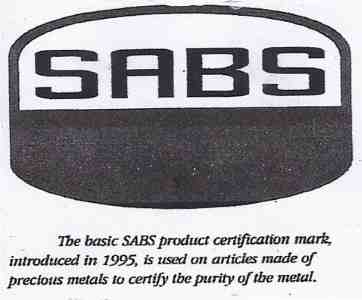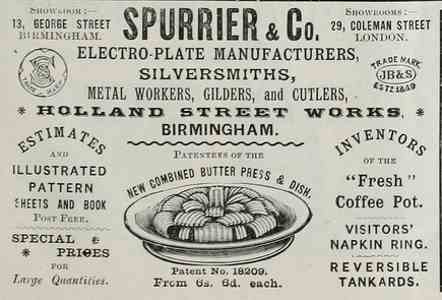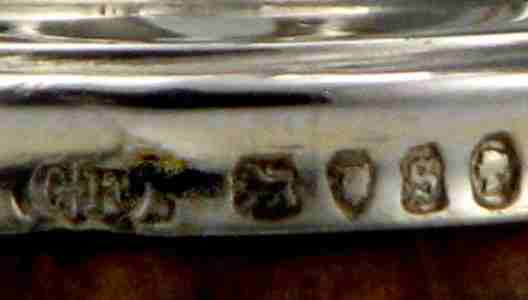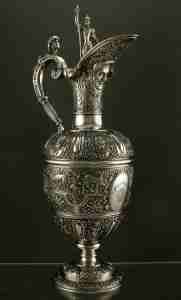 newsletter
# 140 January 2016
newsletter
# 140 January 2016www.ASCASonline.org SITE MAP
email: silverassociation@yahoo.it
YOUR GUIDE TO JANUARY NEWSLETTER: articlesnew members members' windowmail to ASCAS replies to questions a page per month a silversmith per month a word per month a book on my shelf a crest per month contributors to this Newsletter search engine disclaimer and privacy policy 2016 ASCAS membership
|
top page - page map |
Mail to ASCAS: e-mail
silverassociation@yahoo.itDean Hansen writes:
... Are these mark associated with a silver plate or sterling silver?
I found it in a silver tray. I was told by a jeweller it was associated to a Jewish tray.
Dean Hansen
It's a silverplate mark by Barker Ellis, see my website at
http://www.silvercollection.it/electroplatesilverB.html#BARKER
Giorgio Busetto
David N Boddy writes:
Here are two pics of my mystery object which I am hoping one of your members can perhaps identify for me.
The piece is hallmarked Birmingham 1939 and made by Richard Burbridge.
The javelin like middle piece unscrews from the finial and each piece is separately hallmarked ... but what is it?
I thought maybe some implement to eat escargots.
Anyhow hope one of your members can help out.
Kind wishes
David N Boddy
Possibly your item is 'part' of an object (not the whole). Any suggestion will be welcome.
Giorgio Busetto
Sherry S. Sorkness writes:
... I bought this below silver tea infuser.
The Hallmark is a G with a crown over it and directly under that there is an iron cross.... it also has a Germany mark.
I Identified the hallmark as Germany (Allemagne) Goerliz XVI.... but really can find anything further.
Can someone please help?
Sherry S. Sorkness
In XVI century tea was unknown in Europe. I believe it's a Hanau silver, possibly maker Wolf & Knell.
Giorgio Busetto
Robin Gibson writes:
... I have a silver plated ladle marked S.S & Co B which I am advised might be Saunders & Shepherd, Birmingham. Do you think this advise is correct?
Also, there is a set of 4 ladles each marked (B) (&) (Co) (S) ( EPNS - in a shield ). Do you think this might be Edwin Blyde & Co?
If you can advise me I will be extremely grateful.
Kind regards
Robin Gibson
The B&CO mark belongs, possibly, to Buxton & Co, Sheffield (this is only a hypothesis).
The S.S. & Co mark belongs to Selig, Sonnenthal & Co, London and Sheffield, see my website at
http://www.silvercollection.it/electroplatesilverS.html
Giorgio Busetto
Robin Holmes writes:
... I have this interesting looking vase. I am stumped by the two marks the more elaborate of which is on the upper surface of the foot/base and the other on the underside.
Identifying country of origin would help to perhaps understand the method employed as well as perhaps the approximate date of manufacture.
Best regards,
Robin Holmes
Andrea Agati writes:
... I need your help to identify this silversmith active in Milan (Italy). The mark is MI32.
Andrea Agati
The maker is Messulam, see my website at
http://www.silvercollection.it/SILVERSMITHSMI1.html
Giorgio Busetto
"A PAGE per MONTH"
In this column we presents a page obtained from makers'
brochures, books, auction catalogs, advertising or whatever
other printed paper, related to silver, that may be of interest
for ASCAS members.
The images will be published at a "low resolution" level and for
private and personal use only.
This column is published under the kind permission of Giorgio
Busetto's website
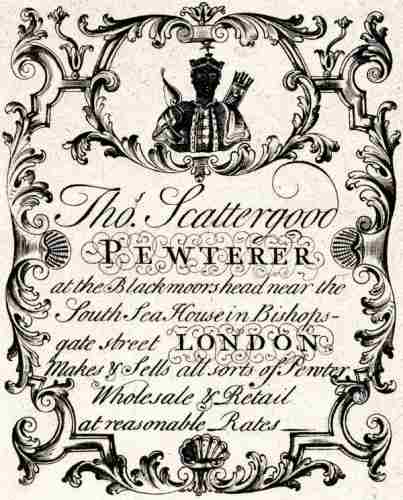 |
This month ASCAS presents an ancient trade card:THOMAS SCATTERGOODPewterer active at the Back's moor head near the South Sea House in Bishopsgate Street, London
|
"A WORD per MONTH"
In this column we present an abstract from a page of the "What is? Silver Dictionary"courtesy of
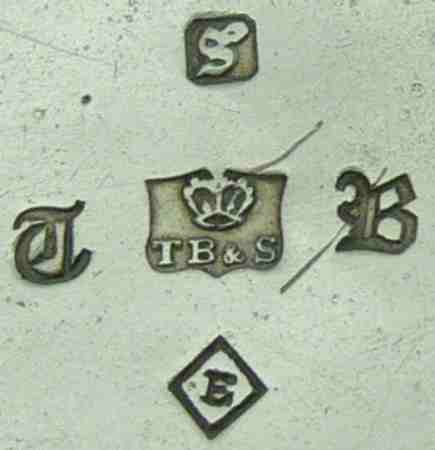
|
PSEUDO HALLMARKS IN BRITISH SILVERPLATEThere was no legal requirement to mark electroplated goods and any letter, symbol or number punched in silverplate wares is part of the individual trademark used by manufacturers to customize their own production.Silverplate was used by lower classes as an affordable substitute of sterling silver and UK makers, to gratify the ambition of their customers, often adopted punches composed of a sequence of symbols and letters similar to that used by Assay Offices for sterling silver hallmarking. To prevent abuses and to avoid confusion, the 'crown' symbol in silver plate wares was banned in 1896, reserving its use to sterling silver hallmarked by Sheffield Assay Office. However, the use of pseudo hallmarks was a common practice in the Victorian era and most UK manufacturers used trade marks consisting in their initials coupled to '&', 'S' (for Sons or Sheffield), 'EP' (for Electro Plate) and a profusion of symbols inside outlines of various shape (circles, shields, squares) obtaining a result very similar to that present in sterling silver wares..... more |
"A SILVERSMITH per MONTH"
In this column
we present marks, information and history of silversmiths and
silver manufacturers.
This column is published under the kind permission of Giorgio
Busetto's website

|
|
SPURRIER & CO
|
"A CREST per MONTH"
In this column we
present images and descriptions of Crests and Mottoes of British,
Irish and Scottish families as engraved on silver items.
This column is published under the kind permission of Giorgio
Busetto's website

FAMILY CRESTS: LIST OF NAMES
M'HARDIE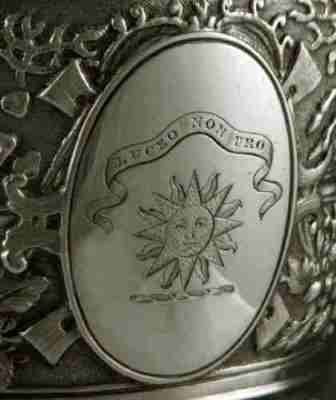
|
The crest of the Scottish family M'Hardie
|
Closing our JANUARY 2016 edition of ASCAS Newsletter I hope
you have appreciated its content.
Your comments, suggestions and advice will be of great help.
My thanks to Andrea Agati, David N Boddy, Robin Gibson, Dean Hansen, Robin Holmes, Sherry S. Sorkness, Fred van Staden
for their precious
contributions.
Giorgio Busetto
Secretary
DISCLAIMER AND PRIVACY POLICYASCAS is a community of people having a common
interest in antique silver.
|
